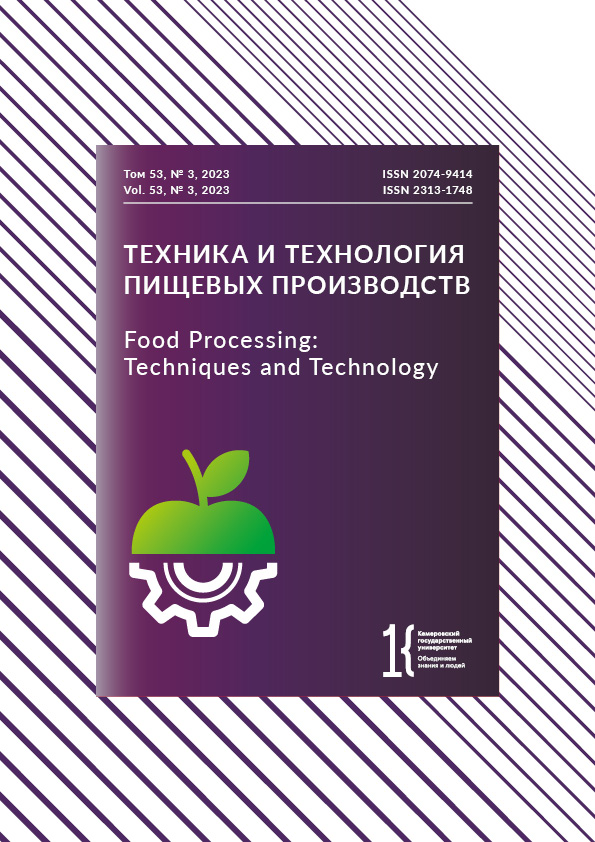Москва, Россия
Москва, Россия
Москва, Россия
Москва, Россия
сотрудник с 01.01.1992 по 01.01.2025
Москва, Россия
Москва, Россия
Москва, Россия
Чёрная смородина (Ribes nigrum L.) является одной из самых доступных в России ягод, которую можно использовать в здоровом питании. Цель исследования – характеристика пищевой ценности ягод чёрной смородины и продуктов их переработки с позиции удовлетворения физиологической потребности человека в витамине С, антоцианах, пищевых волокнах, и оценка их использования в пищевой промышленности и питании. В ходе работы провели анализ оригинальных исследовательских и обзорных статей на русском и английском языках, опубликованных в научных журналах в ретроспективе с 2015 по 2023 гг., индексируемых базами данных РИНЦ и Pubmed. Поиск осуществляли по ключевым словам: «blackcurrant» и ли «чёрная смородина». Ягоды чёрной смородины содержат значительные количества пищевых волокон, полифенольных соединений, антоцианов, витамина С и калия, благодаря чему являются источником этих пищевых веществ, в значительной мере покрывая потребность человека в этих нутриентах. Добавление ягод или вторичных продуктов их переработки в кисломолочные, зерновые пищевые продукты в количестве 5–20 % взамен основного сырья позволяет достигнуть их обогащения пищевыми волокнами, витамином С, антоцианами, снизить калорийность. Ягоды чёрной смородины и вторичные продукты их переработки, содержащие цвето-, вкусо- и ароматобразующие соединения, используются при производстве различных спиртных напитков. В технологическом отношении выжимки ягод являются функциональным ингредиентом, обладающим влагоудерживающей способностью, повышающим антиоксидантную способность продукта. Сок (1,43 %) и водный экстракт выжимок применяют в составе маринадов для рыбной и мясной продукции, что повышает их микробиологическую безопасность и увеличивает срок годности. Результаты исследований подтверждают целесообразность комплексной переработки ягод чёрной смородины, которые являются ценным источником пищевых волокон, витамина С и антоцианов. Вторичные продукты их переработки представляют собой концентрат пищевых волокон, содержащий значительное количество природных антиоксидантов. При разработке функциональных пищевых продуктов – источников биологически активных веществ – необходимо руководствоваться критериями, предъявляемыми к обогащенным продуктам. Добавление небольших количеств ягодного сырья и побочного сырья из них, потенциально являющихся источником ценных биологически активных веществ, хотя и послужит расширению ассортимента пищевых продуктов, но не позволит достигнуть цели обогащения дефицитными в рационе человека биологически активными веществами и снизить общую калорийность.
Чёрная смородина, выжимки ягод, пищевые волокна, фенольные соединения, витамин С, пищевые продукты, обогащение
1. Prichko TG, Droficheva NV. Use of perspective varieties of black currant in the formation of products of medicinal and preventive purpose. Innovations and Food Safety. 2019;(4):109–116. (In Russ.) https://doi.org/10.31677/2311-0651-2019-26-4-109-116
2. Prichko TG, Droficheva NV, Smelyk TL. Chemical quality parameters of berries of black currant cultivars. North Caucasian Federal Scientific Center of Horticulture, Viticulture, Wine-making. 2019;25:123–127. (In Russ.). https://doi.org/10.30679/2587-9847-2019-25-123-127; https:/elibrary.ru/JFOCYA
3. Cho J, Kim H-J, Kwon J-S, Kim H-J, Jang A. Effect of Marination with Black Currant Juice on the Formation of Biogenic Amines in Pork Belly during Refrigerated Storage. Food Science of Animal Resources. 2021;41(5):763–778. https://doi.org/10.5851/kosfa.2021.e34
4. Reißner A-M, Rohm H, Struck S. Sustainability on Bread: How Fiber-Rich Currant Pomace Affects Rheological and Sensory Properties of Sweet Fat-Based Spreads. Foods. 2023;12(6):1315. https://doi.org/10.3390/foods12061315
5. Djordjević B, Djurović D, Zec G, Zagorac DD, Natić M, Meland M, et al. Does Shoot Age Influence Biological and Chemical Properties in Black Currant (Ribes nigrum L.) Cultivars? Plants. 2022;11(7):866. https://doi.org/10.3390/plants11070866
6. Marsol-Vall A, Kortesniemi M, Karhu ST, Kallio H, Yang B. Profiles of Volatile Compounds in Blackcurrant (Ribes nigrum) Cultivars with a Special Focus on the Influence of Growth Latitude and Weather Conditions. Journal of Agricultural and Food Chemistry. 2018;66(28):7485–7495. https://doi.org/10.1021/acs.jafc.8b02070
7. Akimov MYu, Bessonov VV, Kodentsova VM, Eller KI, Vrzhesinskaya OA, Beketova NA, et al. Biological value of fruits and berries of Russian production. Problems of Nutrition. 2020;89(4):220–232. (In Russ.). https://doi.org/10.24411/0042-8833-2020-10055; https://elibrary.ru/UOAQLM
8. Shelenga TV, Popov VS, Konarev AV, Tikhonova NG, Tikhonova OA, Kerv YuA, et al. Metabolomic profiles of Ribes nigrum L. and Lonicera caerulea L. from the collection of the N.I. Vavilov Institute in the setting of Northwest Russia. Vavilov Journal of Genetics and Breeding. 2022;26(7):630–636. (In Russ.). https://doi.org/10.18699/VJGB-22-77
9. Timusheva OK, Sorokopudov VN. Comparative evaluation of black currant varieties in the conditions of the middle subzone of the taiga of the Komi Republic. Vegetable Crops of Russia. 2023;(3):73–78. (In Russ.). https://doi.org/10.18619/2072-9146-2023-3-73-78
10. Tian Y, Laaksonen O, Haikonen H, Vanag A, Ejaz H, Linderborg K, et al. Compositional Diversity among Blackcurrant (Ribes nigrum) Cultivars Originating from European Countries. Journal of Agricultural and Food Chemistry. 2019;67(19):5621–5633. https://doi.org/10.1021/acs.jafc.9b00033
11. Ejaz A, Waliat S, Afzaal M, Saeed F, Ahmad A, Din A, et al. Biological activities, therapeutic potential, and pharmacological aspects of blackcurrants (Ribes nigrum L): A comprehensive review. Food Science and Nutrition. 2023;11(10):5799–5817. https://doi.org/10.1002/fsn3.3592
12. Alba K, Macnaughtan W, Laws AP, Foster TJ, Campbell GM, Kontogiorgos V. Fractionation and characterisation of dietary fibre from blackcurrant pomace. Food Hydrocolloids. 2018;81:398–408. https://doi.org/10.1016/j.foodhyd.2018.03.023
13. Скурихин И. М., Тутельян В. А. Химический состав российских пищевых продуктов. Москва: ДеЛи принт, 2002. 236 c.
14. Kowalski R, Gustafson E, Carroll M, de Gonzalez ME. Enhancement of Biological Properties of Blackcurrants by Lactic Acid Fermentation and Incorporation into Yogurt: A Review. Antioxidants. 2020;9(12):1194. https://doi.org/10.3390/antiox9121194
15. Бакин И. А., Мустафина А. С., Вечтомова Е. А., Колбина А. Ю. Использование вторичных ресурсов ягодного сырья в технологии кондитерских и хлебобулочных изделий // Техника и технология пищевых производств. 2017. Т. 45, № 2. С. 5–12. https://elibrary.ru/ZCOQCZ
16. Apak R. Current Issues in Antioxidant Measurement. Journal of Agricultural and Food Chemistry. 2019;67(33):9187–9202. https://doi.org/10.1021/acs.jafc.9b03657
17. Trych U, Buniowska M, Skąpska S, Kapusta I, Marszałek K. Bioaccessibility of Antioxidants in Blackcurrant Juice after Treatment Using Supercritical Carbon Dioxide. Molecules. 2022;27(3):1036. https://doi.org/10.3390/molecules27031036
18. Кошелева О. В., Коденцова В. М. Содержание витамина С в плодоовощной продукции // Вопросы питания. 2013. Т. 83, № 3. С. 45–52. https://elibrary.ru/QLIFDV
19. Мясищева Н. В., Макаркина М. А., Князев С. Д. Использование свежих и замороженных ягод черной смородины в технологии желейных продуктов // Пищевая промышленность. 2017. № 3. С. 18–21. https://elibrary.ru/YNDGAN
20. Бакин И. А., Мустафина А. С., Лунин П. Н. Изучение химического состава ягод черной смородины в процессе переработки // Вестник КрасГАУ. 2015. № 6. С. 159–162. https://elibrary.ru/UDTMFZ
21. Archaina D, Sosa N, Rivero R, Schebor C. Freeze-dried candies from blackcurrant (Ribes nigrum L.) and yoghurt. Physicochemical and sensorial characterization. LWT. 2019;100:444–449. https://doi.org/10.1016/j.lwt.2018.10.049
22. Cosmulescu S, Trandafir I, Nour V. Mineral composition of fruit in black and red currant. South Western Journal of Horticulture, Biology and Environment. 2015;6(1):43–51.
23. Cortez RE, de Gonzalez ME. Blackcurrants (Ribes nigrum): A review on chemistry, processing, and health benefits. Journal of Food Science. 2019;84(9):2387–2401. https://doi.org/10.1111/1750-3841.14781
24. Максименко М. Г. Изменение химического состава смородины чёрной при разных способах консервирования // Пищевая промышленность: наука и технологии. 2017. № 3. С.27–31. https://elibrary.ru/YQANBE
25. Makarova NV, Ignatova DF, Vasilyeva EA, Solina YuI, Eliseeva EA. Development of a technology for the production of snacks based on blackcurrant berries (Ribes nigrum). Proceedings Of the Voronezh State University of Engineering Technologies. 2019;81(3):158–167. https://doi.org/10.20914/2310-1202-2019-3-158-167. (In Russ.). https://doi.org/10.20914/2310-1202-2019-3-158-167; https://elibrary.ru/JYKSUH
26. Yucel EE, Kaya C. Effect of jam and marmalade processing and storage on the phytochemical properties of currant cultivars (Ribes spp.) Journal of Food Processing and Preservation. 2021. https://doi.org/10.1111/jfpp.15820
27. Свечникова Е. М., Усубалиева А. М., Кожобекова К. К. Содержание витамина С в джеме из черной смородины, выращенной в Иссык-кульской области // Наука, новые технологии и инновации Кыргызстана. 2018. № 2. С. 39–40. https://elibrary.ru/XSHLNR
28. Zakharov VL, Zubkova TV. Berry additives effect on the cottage cheese quality and preservation. Bulletin of KSAU. 2022;(5):200–205. (In Russ.). https://doi.org/10.36718/1819-4036-2022-5-200-205; https://elibrary.ru/CXOEEW
29. Третьякова Е. Н., Нечепорук А. Г. Функциональный полуфабрикат из творога с пищевыми волокнами и ягодами черной смородины и клюквы // Технологии пищевой и перерабатывающей промышленности АПК – продукты здорового питания. 2016. № 3. С. 62–67. https://elibrary.ru/WNGAFN
30. Rogachikova NM, Serpunina LT. Study of efficiency of use of berry powders in the technology of the soft cheese without ripening. Cheese- And Buttermaking. 2020;(3):30–32. (In Russ.). https://doi.org/10.31515/2073-4018-2020-3-30-32; https://elibrary.ru/XOXDYX
31. Chernyshenko YuN, Yarmukhamedova EI, Krupina OV, Mironova IV. Development of functional fermented milk products with berry fillings. Russian Electronic Scientific Journal. 2022;(4):55–65. (In Russ.). https://doi.org/10.31563/2308-9644-2022-46-4-55-65; https://elibrary.ru/RJHXVL
32. Schmidt C, Geweke I, Struck S, Zahn S, Rohm H. Blackcurrant pomace from juice processing as partial flour substitute in savoury crackers: Dough characteristics and product properties. International Journal of Food Science and Technology. 2018;53(1):237–245. https://doi.org/10.1111/ijfs.13639.
33. Mäkilä L, Laaksonen O, Diaz JMR, Vahvaselkä M, Myllymäki O, Lehtomäki I, et al. Exploiting blackcurrant juice press residue in extruded snacks. LWT- Food Science and Technology. 2014;57(2):618–627. https://doi.org/10.1016/j.lwt.2014.02.005
34. Коденцова В. М., Вржесинская О. А., Спиричев В. Б., Шатнюк Л. Н. Обоснование уровня обогащения пищевых продуктов витаминами и минеральными веществами // Вопросы питания. 2010. Т. 79, № 1. С. 23–33. https://elibrary.ru/NDLOZX
35. Zeng Y, Zhou W, Yu J, Zhao L, Wang K, Hu Z, et al. By-Products of Fruit and Vegetables: Antioxidant Properties of Extractable and Non-Extractable Phenolic Compounds. Antioxidants. 2023;12(2):418. https://doi.org/10.3390/antiox12020418.
36. Оганесянц Л. А., Песчанская В. А., Дубинина Е. В., Трофимченко В. А. Подбор рас дрожжей для сбраживания фруктовой мезги, предназначенной для дистилляции // Пиво и напитки. 2017. № 6. С. 26–30. https://elibrary.ru/YMJWHX
37. Kelanne NM, Siegmund B, Metz T, Yang B, Laaksonen O. Comparison of volatile compounds and sensory profiles of alcoholic black currant (Ribes nigrum) beverages produced with Saccharomyces, Torulaspora, and Metschnikowia yeasts. Food Chemistry. 2022;370:131049. https://doi.org/10.1016/j.foodchem.2021.131049
38. Nanashima N, Horie K, Kitajima M, Takamagi S, Mikami K, In N, et al. Hypocholesterolemic Effect of Blackcurrant (Ribes nigrum) Extract in Healthy Female Subjects: A Pilot Study. Molecules. 2021;26(13):4085. https://doi.org/10.3390/molecules26134085
39. Kelanne N, Yang B, Liljenbäck L, Laaksonen O. Phenolic Compound Profiles in Alcoholic Black Currant Beverages Produced by Fermentation with Saccharomyces and Non-Saccharomyces Yeasts. Journal of Agricultural and Food Chemistry. 2020;68(37):10128–10141. https://doi.org/10.1021/acs.jafc.0c03354
40. Sommer S, Hoffmann JL, Fraatz MA, Zorn H. Upcycling of black currant pomace for the production of a fermented beverage with Wolfiporia cocos. Journal of Food Science and Technology. 2023;60(4):1313–1322. https://doi.org/10.1007/s13197-023-05677-4
41. Chitarrini G, Debiasi L, Stuffer M, Ueberegger E, Zehetner E, Jaeger H, et al. Volatile Profile of Mead Fermenting Blossom Honey and Honeydew Honey with or without Ribes nigrum. Molecules. 2020;25(8):1818. https://doi.org/10.3390/molecules25081818
42. Rimareva LV, Serba EM, Sokolova EN, Ignatova NI, Fursova NA. On the question of the expediency of using black currant berries to obtain original grain-fruit distillates. Food Industry. 2023;(5):61–63. (In Russ.). https://doi.org/10.52653/PPI.2023.5.5.017; https://elibrary.ru/YQKFEI
43. Kalinina AG, Abramova IM. Golovacheva NE. Morozova SS, Galliamova LP. Investigation of the effect of blackcurrant alcohol-based mors in the composition of an alcoholic beverage on the degree of intoxication of laboratory animals with ethyl alcohol. Food Industry. 2021;(9):29–31. (In Russ.). https://doi.org/10.52653/PPI.2021.9.9.009; https://elibrary.ru/exjadz
44. Roasto M, Mäesaar M, Püssa T, Anton D, Rätsep R, Elias T, et al. The Effect of Fruit and Berry Pomaces on the Growth Dynamics of Microorganisms and Sensory Properties of Marinated Rainbow Trout. Microorganisms. 2023;11(12):2960. https://doi.org/10.3390/microorganisms11122960
45. Hutchison AT, Flieller EB, Dillon KJ, Leverett BD. Black currant nectar reduces muscle damage and inflammation following a bout of high-intensity eccentric contractions. Journal of Dietary Supplements. 2016;13(1):1–15. https://doi.org/10.3109/19390211.2014.952864
46. Nosal BM, Sakaki JR, Macdonald Z, Mahoney K, Kim K, Madore M, et al. Blackcurrants Reduce the Risk of Postmenopausal Osteoporosis: A Pilot Double-Blind, Randomized, Placebo-Controlled Clinical Trial. Nutrients. 2022;14(23):4971. https://doi.org/10.3390/nu14234971
47. Konić-Ristić A, Šavikin K, Zdunić G, Besu I, Menković N, Glibetić M, et al. Acute effects of black currant consumption on salivary flow rate and secretion rate of salivary immunoglobulin a in healthy smokers. Journal of Medicinal Food. 2015;18(4):483–488. https://doi.org/10.1089/jmf.2013.0149
48. Khan F, Ray S, Craigie AM, Kennedy G, Hill A, Barton KL, et al. Lowering of oxidative stress improves endothelial function in healthy subjects with habitually low intake of fruit and vegetables: A randomized controlled trial of antioxidant-and polyphenol-rich blackcurrant juice. Free Radical Biology and Medicine. 2014;72:232–237. https://doi.org/10.1016/j.freeradbiomed.2014.04.006
49. Ciudad-Mulero M, Domínguez L, Morales P, Fernández-Ruiz V, Cámara M. A Review of Foods of Plant Origin as Sources of Vitamins with Proven Activity in Oxidative Stress Prevention according to EFSA Scientific Evidence. Molecules. 2023;28(21):7269. https://doi.org/10.3390/molecules28217269
50. Pérez-Lamela C, Franco I, Falqué E. Impact of High-Pressure Processing on Antioxidant Activity during Storage of Fruits and Fruit Products: A Review. Molecules. 2021;26(17):5265. https://doi.org/10.3390/molecules26175265











